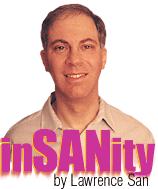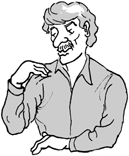 |
|
||||||||||||
|
About San
inSANity columns: The
Better You Are, When
The Bastards Ugly Brides and Other Temptations Will The Real Freaks Please Raise Their Hands? The Fine Art of Kicking Yourself |
The most essential gift for a good writer is a built-in, shock-proof, shit detector. This is the writer's radar and all great writers have had it. Last time, we looked at the non-coincidental fact that the best people in every field tend also to be the most self-critical. We also confronted the trap of confusing neurotic self-abasement with constructive self-criticism. Playing with neurosis is always fun, but this time I want to concentrate on a different aspect of self-criticism: the importance of speed. Specifically, the speed with which you can identify your own errors. You've heard of speed-reading, or speed-writing? Well, speed-criticism matters because it can mean the difference between work that's just a hobby and work that can be a profession. Speed-criticism is what allows you to have a conversation with yourself about what's wrong with your work as you're doing it. Why is this so important? It's not just about saving time; it also affects the quality you can ultimately achieve. Drawings on Ice Once upon a time, I couldn't draw very well. Oh, I thought I could: being raised in a family where the ability to draw was considered a minimal threshold for any claim to intelligence or even humanity, we all thought we could draw. I would take my drawings, which looked good to me, and put them in a drawer, and then forget about them. Then, maybe six months later, I'd accidentally find those same drawings and look at them again. And I'd see that they were bad. And I'd destroy them. I can guess what you're thinking: I had improved my drawing skills in the intervening six months and so improved my critical eye. I wish. No, unfortunately I was simply looking at my drawings with (as the trite phrase goes) a fresh eye, not an improved one; but a fresh eye was sufficient to see the problems. The needle on my internal crap meter had rested near zero while I was actually working on the drawings. (Hey, if Hemingway can have a shit detector, I can have a crap meter.) But the needle twitched alarmingly when I saw those same drawings later on. It gets worse. Every work process involves your making a whole series of unconscious assumptions -- they mostly have to be unconscious, or you'd work so slowly that you'd never get the job done. Unfortunately, some of these assumptions entail faulty logic. (Perhaps they were logical when you first learned them in some other, slightly different context.) Not only that, but once you're headed down an illogical path, you're forced to periodically invent even more illogic to reconcile the contradictions you're already stuck in. Faulty assumptions are fecund little bastards; they tend to spawn each other and then get glued into a chain of dependent errors. Give That Man a Hand If this is unclear, a simple example may help. Let's say I'm sketching a person touching his right shoulder with his right hand, and I'm drawing it without benefit of a model. Here's roughly the way it should look:
However, if I made a false assumption about the length of the forearm -- if I made it too short compared to the upper arm -- then the forearm might come out like this:
Now, assuming I've failed to recognize my initial false assumption, how am I going to connect the fingertips to the shoulder? I know that somehow a person's fingers can reach their shoulder, so I'm likely to compensate for the short forearm by drawing the hand longer than it should be, like this:
Even if you're not a visual artist, you can still see the pattern here. Errors trigger other errors. Not seeing the first mistake "forces" you to make the second mistake -- and you're likely to be blind to that one too. Why? You (unconsciously) want to accept your own chain of dependent errors, because you've already invested time and effort in it. This in turn requires your mind to ignore its own deeper wisdom that (on an even more unconscious level) probably knows perfectly well that you're screwing up. To hide this whole delusional mess from yourself, you generate a fog of confusion so thick that you can't see the ugly forest you're building -- you're too busy yanking on the deformed trees, struggling to get the poor things to line up. If I had set the drawing aside after step 1 (drawing the forearm wrong) but before step 2 (drawing the hand), and looked at it a week later, I might have seen the problem and re-drawn the forearm rather than mis-drawn the hand. But is that delay realistic? That might be okay for a hobby artist, but a professional artist would starve while waiting for his vision (actually his brain) to clear. We often talk about seeing things with a "fresh eye," and (hackneyed phrase or not) the mind really does seem to work that way -- that is, your self-criticism is often more accurate when a period of time has elapsed since you originally did the deed. Intuitively, it seems obvious that this should be so, but... why does it work that way? An Analysis of the Fresh-Eyeball Phenom
I suspect that the combination of these three factors is what's really behind the phenomenon popularly known as "looking at something with a fresh eye." However, the fresh-eye thing is slow. Interesting but slow. I said this column is about speed, remember? Even if, as a working professional, I had the luxury of time to invoke the fresh-eye phenomenon, I doubt it would help much. What good is it for me to see that my six-month-old drawing is a mess? That may be somewhat educational, but am I really going to fix the drawing at that point? Waste of time. I'm more likely to start -- and mess up -- another one. Revelation While Staring at a Naked Woman One day in art school a long time ago, I was sitting on a stool, staring hatefully at the nude model whose muscles I couldn't quite decipher, only occasionally glancing at the paper (artists are taught to keep their eyes on the model) while sketching with charcoal. Art students use charcoal because you can erase it with the flick of a rag. As usual, I would draw, flick, draw, flick -- the erasing was less a logical process than a bad habit, a reflex born out of desperation. But on this particular day, I somehow refocused my mind, and slowly the drawing started to get better. Gradually I realized that I had passed a sort of milestone. I still didn't really understand the model's anatomy, but an internal, self-critical conversation had begun. Eventually I was to learn that if I could "hear" my inner dialog about the work process, it meant that I hadn't fully mastered that process -- the deepest skills are always deeply unconscious. But at that point, even having the conversation with myself was progress. "No, San, that's wrong -- that line slants down -- drive towards the vanishing point -- the clavicles obey three-point perspective just like a building would." The silent dialog was too conscious and labored to be ideal, but the important thing was that it was happening while the work was actually progressing; I was starting to see my faulty assumptions in real time, as I made them. My internal crap meter had speeded up. I was soon to discover that the ability to see errors in real time, as the errors are made, can quickly lead to the ability not to create those problems in the first place. In fact, this internal, real-time feedback loop is one of the key prerequisites for professional-quality work. OK, Time to Torture Myself About This Column The cleverest of all, in my opinion, is the man who calls himself a fool at least once a month. Well, I'm not sure I've helped you much. I haven't told you how to speed up your own crap meter, how to criticize what you're doing as you're doing it, how to merge, as Thomas Dewey called it, the "doing" and the "undergoing." I can't tell you how one gets to that stage, because I don't exactly know. It has something to do with desire. It clearly requires practice. Perhaps more than anything else, it depends on being open to your own criticism. Not an easy state of mind to achieve -- especially when you realize that, if you're a professional who's aiming at greatness, you need to be both the toughest and the fastest critic of your own work that you'll ever encounter. |
|||||
|
San was the founding editor of 1099 Magazine, serving as its first editor-in-chief and creative director. He's now back in the boss-free world as a freelance writer and illustrator. In addition to the inSANity column on 1099, San's other writings and cartoons are at www.sanstudio.com. We'd love to hear your feedback about this column. |
||||||
|
|
||||||
The 1099 name and logo are trademarks of 1099 Magazine.





